| PORTRAITS OF DENIAL & DESIRE Sepia Prints (2014 - Present) |
 |
Ibrahim Essa. Digital Print. Sepia. |
Abu Rayek - Ibrahim Essa. Born 1935 Kafr Bir’im, Palestine. Lives in Jish, Israel. Abu Rayek is an internally displaced refugee from the village of Kafr Bir’im, located in the Northern Galilee. After being displaced from his village at the age of thirteen and half, Abu Rayek managed to return to historical Palestine where his identity as a Palestinian continues to be denied. He became in the eyes of the world, a so-called Israeli-Arab, and a third class non-Jewish citizen, of the so-called Jewish State. Most of the 15% of the Palestinian population that managed to remain or return to the land that became Israel were internally displaced refugees. The majority of them came from farming villages and were destined to follow their ancestors’ tradition and become farmers. But as their lands were confiscated by the newly established colonial state, the only work they could find was as poorly paid field hands on the farms that were stolen from then, or more commonly, as day laborers who literally built the physical structures of Israel. It is tremendously ironic that the once indigenous masters of the land became the servants of the settler colonial state. Palestinian laborers built the kibbutz, the moshaves, the towns, apartment buildings, synagogues, community centers and the factories of the Zionist state that stole their land, destroyed their culture and scattered their families. After loosing all of his ancestral land, Abu Rayek spent his entire adult life as a construction worker, as well as fighting to return to and rebuild his destroyed village. Although he has not yet succeeded in returning to live in his village, he managed to rebuild the cemetery of that village, so that the people of Kafr Bir’im, now scattered all over the world, could at least be buried in their native soil. The agricultural kibbutz that was built on the orchards and fields expropriated from Kafr Bir’im in 1948 sends their cows to graze freely on the land. The cows constantly trample the cemetery and defecate all over the graves. Abu Rayek built a chain link fence to keep the cows out of the cemetery. But members of the kibbutz, unhappy with the loss of even a small patch of the grazing land they stole, and undeterred by the desecration of the graves of Palestinians, quickly tore down the fence. Abu Rayek told me that every time they tear it down, he puts it back up and expands the cemetery by a couple of yards, reclaiming his village and homeland, two meters at a time.
|
